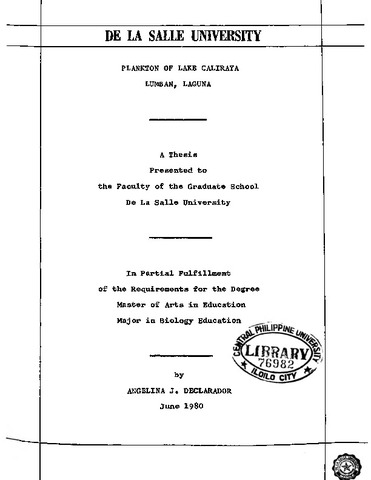Plankton of Lake Caliraya, Lumban, Laguna

Page views
1,044Petsa
1980May-akda
Tagapangulo ng Panel ng Depensa
Magbahagi
Metadata
Ipakita ang buong tala ng item
Abstract
A lake is a rich community of diverse microscopic plant population and animal population affected by physical and chemical factors. The immediate environment of aquatic organisms is water; therefore, a study of the factors in the water that would affect the growth of plankton, such as pH, salinity, and temperature, is a necessary approach to the knowledge of the ecosystem existing between the organism and the external environment. These factors in the environment make possible for the existence of varying degrees of biological productivity.
The existing quality or quantity of phytoplankton species may depend on the nature of the environment. Larger and deeper bodies of water as lakes have been known to show a greater uniformity in species than smaller ones. On the basis of uniformity in species present, lakes are classified into two types; the Caledonian and the Baltic lakes. (Welch, 1952). In Caledonian lakes, desmids are predominant with a few Myxophyceae and Chlorococcales. Baltic lakes show a conspicuous lack of desmids and predominance of Myxophyceae and Chlorococcales. The former type is characteristically rich in species though poor in bulk; the later has relatively few species usually present in considerable quantities.
The demand of chlorophyll-bearing phytoplankton for sufficient effective light predetermine the depth to which they may be distributed in ponds or stream and lakes. In abundance, the phytoplankton gives the water a greenish color. In large, deep ponds, stream or lakes (as well as in the ocean) phytoplankton is much important than in rooted vegetation in the production of the basic food for the ecosystem.
Smaller water bodies like ponds do not show a qualitative uniformity in phytoplankton species. Diversification commonly occurs during the summer months in temperate countries. Other features make pond phytoplankton distinct from that of lakes. They are in greater number of Myxophyceae, desmids, and flagellates and its lack of diatom common in lakes.
Freshwater microscopic vegetation and zooplankton form the nutritional basis of all aquatic life, directly or indirectly. The phytoplankton constitute the chief food supply for most non- chlorophyll bearing members of the assemblage. These in turn provide nourishment for the benthic, limnetic, and emergent faunas. Fishes and other non-plankton animals are also wholly or partly dependent on phytoplankton throughout or during some stages in their life cycle.
Recent researches have shown a promise of the civilization of plankton algae for human consumption.
The vitamin content of some species, like diatoms already ascertained. The vitamin supply particularly of A and B now commercially obtained from liver of halibut, shark, and similar fishes were derived originally from synthesis by plankton algae. Some attention has been given to the vitamin content of marine plankton (Drummond and Gunther, 1930; Russel, 1930) and at least one vitamin, (Vitamin A) has been found.
In freshwater plankton, thiamin and niacin have been identified (Hutchinson, 1943); (Hutchinson and Setlow, 1946). It seems, almost certain, that still others awaits discovery. There is reason for believing that various freshwater animals depends upon the phytoplankton for their vitamin supply.
The phytoplankton also have a considerable influence, living or dead on their environment. Active influence in the form of purely physiological or active biochemical and inactive or purely physical influence.(Welch, 1952). They alter the chemistry of water by the removal or addition of dissolved gases and nutrient.
Very high amounts of suspended materials may interfere with the illumination by causing high turbidities; may affect color and odor of the water in the case of "blooms” and thereby pronounced influence on other aquatic life such as the death of fishes and other organisms.
In search for indices of lake productivity the role of the phytoplankton has been considered because of its marked influence on aquatic life. Seasonal maxima of phytoplankton has always been correlated with peaks in microfaunal populations. It is not clearly known however, whether the increase in microfauna is direct result of its feeding on phytoplankton (Prescott, 1951).
In view of their great importance, a research is made concerning population density of plankton species in Lake Caliraya. This investigation is centered on the description analysis and identification of existing microorganisms found on different depths and zones of the lakes under varying weather conditions.
Purpose of the Study
This study aims to determine the population density of plankton species of Lake Caliraya, and to determine the physical and chemical features of the habitats which may affect the population density of plankton.
Paglalarawan
Abstract only
Mungkahing Sipi
Declarador, A. J. (1980). Plankton of Lake Caliraya, Lumban, Laguna (Unpublished Master’s thesis). De La Salle University, Manila.
Uri
ThesisMga Paksa
Mga keyword
Kagawaran
Graduate SchoolDegree
Master of Arts in Education major in Biology EducationLokasyon ng Istante
GSL Theses 378.242 D357
Pisikal na paglalarawan
114 leaves
Collections
- Theses [18]

